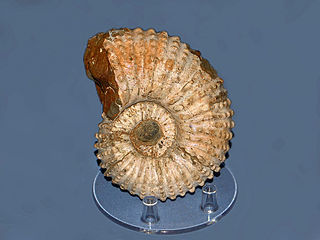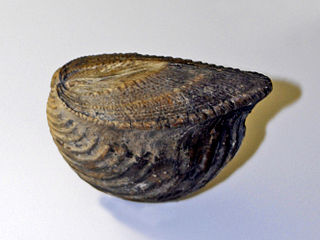 W
WAcanthoceras is an extinct cephalopod genus belonging to the subclass Ammonoidea and family Acanthoceratidae that lived from the Albian to early Coniacian stages of the Cretaceous.
 W
WActinoceramus is an extinct genus of fossil saltwater clams, marine pteriomorphian bivalve molluscs. These bivalves were facultatively mobile infaunal suspension feeders.
 W
WThe Casma Group is a stratigraphic group of Cretaceous sedimentary formations exposed along the coast and within the Cordillera Occidental near Casma, Peru.
 W
WThe Chota Formation is an Early Campanian to Late Eocene geologic formation of the Cajamarca and western Amazonas Region in northern Peru. Dinosaur remains are among the fossils that have been recovered from the formation, although none have yet been referred to a specific genus. The formation was formerly named Bagua Formation.
 W
WThe Chulec Formation (Ki-chu) is a geological formation in Peru whose strata date back to the Albian. The formation has a thickness of about 100 to 200 metres and comprises limestones, marls and calcareous sandstones that were deposited during a marine transgression from the west. Pterosaur remains and ammonites are among the fossils that have been recovered from the formation.
 W
WDouvilleiceras is a genus of ammonites from the Middle to Late Cretaceous. Its fossils have been found worldwide, in Africa, Asia, Europe, and North and South America.
 W
WExogyra is an extinct genus of fossil marine oysters in the family Gryphaeidae, the foam oysters or honeycomb oysters. These bivalves grew cemented by the more cupped left valve. The right valve is flatter, and the beak is curved to one side. Exogyra lived on solid substrates in warm seas during the Jurassic and Cretaceous periods.
 W
WLa Herradura Formation is a sedimentary formation of Lower Cretaceous age exposed near Lima in Peru. The sediments of the formation reflect a marine near-shore depositional environment.
 W
WInoceramus is an extinct genus of fossil marine pteriomorphian bivalves that superficially resembled the related winged pearly oysters of the extant genus Pteria. They lived from the Early Jurassic to latest Cretaceous.
 W
WLyelliceras is a genus of ammonites belonging to the family Lyelliceratidae. These cephalopods were fast-moving nektonic carnivores. They lived in the Cretaceous period, Albian stage.
 W
WMammites is a Late Cretaceous ammonite genus included in the acanthoceratoidean family, Acanthoceratidae, and the type genus for the subfamily Mammitinae. Mammites was named by Laube and Bruder in 1887.
 W
WThe Morro Solar Group is a stratigraphic group of Mesozoic-aged sedimentary formations exposed near Lima, Peru. The groups formations more specifically of Berriasian and Valanginian age and overlies the Jurassic Puente Piedra Group and underlies the Cretaceous Pamplona Formation. The Morro Solar Group is intruded by sills of andesitic composition. Together with the Casma and Imperial Groups, the Morro Solar Group contains clastic volcanosedimentary material derivative of the Mesozoic Casma Volcanic Arc. The formations of the group hosts mostly local fossils which do not have counterparts for biochronological correlation in other regions.
 W
WNeocomites is a genus of ammonite from the Lower Cretaceous, Berriasian to Hauterivian, and type genus for the Neocomitidae.
 W
WPseudoaspidoceras is an extinct genus of ammonites in the family Acanthoceratidae.
 W
WPuzosia is a genus of desmoceratid ammonites, and the type genus for the Puzosiinae, which lived during the middle part of the Cretaceous, from early Aptian to Maastrichtian. Sepkoski defines the range from Albian to Santonian. The generic name comes from the Serbian words "Puž" (snail) and "oce/ose" (axis), gaining its name from the shell's snail-like appearance.
 W
WTissotia is a genus of ammonites belonging to the family Tissotiidae.
 W
WTrigonia is an extinct genus of saltwater clams, fossil marine bivalve mollusk in the family Trigoniidae. The fossil range of the genus spans the Paleozoic, Mesozoic and Paleocene of the Cenozoic, from 298 to 56 Ma.
 W
WThe Vilquechico Formation is a Late Campanian to Late Maastrichtian geologic formation in southern Peru. Fossil ornithopod tracks have been reported from the formation. The formation overlies the Ayabacas Formation and is overlain by the Auzangate Formation.